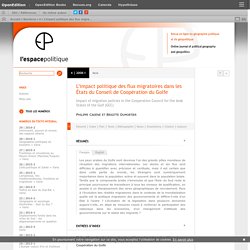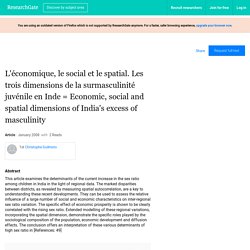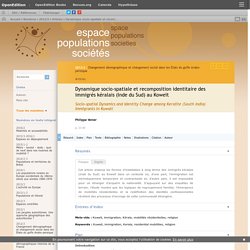

LES NOUVELLES LOGIQUES MIGRATOIRES AU XXIe SIÈCLE [The new logic of migration in the Twenty-First Century] More Than 100 Million Women Are Missing by Amartya Sen. It is often said that women make up a majority of the world’s population.

They do not. This mistaken belief is based on generalizing from the contemporary situation in Europe and North America, where the ratio of women to men is typically around 1.05 or 1.06, or higher. In South Asia, West Asia, and China, the ratio of women to men can be as low as 0.94, or even lower, and it varies widely elsewhere in Asia, in Africa, and in Latin America. How can we understand and explain these differences, and react to them? At birth, boys outnumber girls everywhere in the world, by much the same proportion—there are around 105 or 106 male children for every 100 female children. The fate of women is quite different in most of Asia and North Africa. This pattern is not uniform in all parts of the third world, however.
To account for the neglect of women, two simplistic explanations have often been presented or, more often, implicitly assumed. The case of China deserves particular attention. Letters. 4 MANY FACES OF GENDER INEQUALITY. Indianexpress. AdBlock Plus STEP 1 – Click on the AdBlock Plus icon on the top right of your browser STEP 2 – A drop-down menu will appear with a check mark followed by Enabled on this site STEP 3 – Click the button to until the text reads Disabled on this site STEP 4 – Refresh the page or click Continue to site, to access indianexpress.com Chrome Adblock Extension STEP 1 – Click on the hand icon for adblock extension, on the top right corner of your browser STEP 2 – A drop-down menu will appear.

L’impact politique des flux migratoires dans les États du Conseil de Coopération du Golfe. 1Le Conseil de Coopération des États Arabes du Golfe, dit Conseil de Coopération du Golfe (CCG), inclut les monarchies riveraines du Golfe : le Koweït, Bahreïn, Qatar et les sept émirats fédérés au sein des Émirats Arabes Unis (EAU).

Il comprend également l’Arabie Saoudite dont le centre de gravité religieux se trouve dans le Hedjaz et le centre du pouvoir dynastique dans le Nedj, mais dont les régions pétrolières se situent sur le littoral du Golfe. Il intègre enfin le Sultanat d’Oman qui doit à sa configuration géographique et à son histoire d’être un pays de l’0céan Indien, mais qui d’un point de vue géoéconomique, géopolitique et géostratégique appartient aussi aux pays du Golfe. 2Ces régions arides à très faible densité de population ont connu une croissance démographique et une explosion urbaine spectaculaires alimentées par les migrations internationales de travail après la découverte et l’exploitation des hydrocarbures.
D’après A. Kapiszewski (2006) Estimations A. Les pays du Conseil de coopération du Golfe : à nouvelles tendances migratoires, nouvelles politiques ? J237 1114 GEOS19 DIASPORA INDE GFD en. L'économique, le social et le spatial. Les trois dimensions de la surmasculinité juvénile en Inde = Economic, social and spatial dimensions of India's excess of masculinity. You are using an outdated version of Firefox which is not supported by ResearchGate anymore.

For a faster, safer browsing experience, upgrade your browser now. <div class="c-box-warning full-width-element" style="text-align: center; "><div style="margin: auto; padding:10px;" class="container"><b>For full functionality of ResearchGate it is necessary to enable JavaScript.
Here are the <a href=" rel="nofollow" target="_blank"> instructions how to enable JavaScript in your web browser</a>. </b></div></div> Abstract This article examines the determinants of the current increase in the sex ratio among children in India in the light of regional data. CitationsCitations0ReferencesReferences0 Data provided are for informational purposes only. This publication is from a journal that may support self archiving. Learn more An error occurred while rendering template. rgreq-d9d3646950ad06c0ed84afeda5353f71 false. Peut-on parler d'une diaspora indienne ? Dynamique socio-spatiale et recomposition identitaire des immigrés kéralais (Inde du Sud) au Koweït.
1Depuis le choc pétrolier du début des années 1970, les pétromonarchies du Golfe Persique ont enregistré un accroissement démographique spectaculaire.

Alimentés par l’arrivée de populations étrangères, ces États ont d’abord privilégié les pays arabes puis, se sont peu à peu tournés vers l’Asie du Sud. Au Koweït, cette réorientation de la politique d’immigration fut, sans aucun doute, plus marquée suite à la seconde guerre du Golfe de 1991. Dès lors, les pays sud-asiatiques ont été les principaux pourvoyeurs de main-d’oeuvre immigrée dans ce pays. 2Dans ce schéma migratoire, les ressortissants indiens occupent une place particulière. Présents bien avant l’indépendance, au temps de l’empire britannique, ces derniers ont toujours représenté une part importante de la population étrangère.
Pop et soc francais 423.fr.